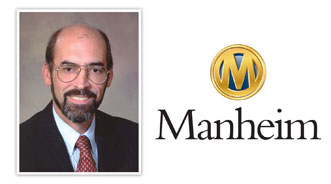Webb: Why Auction Volume Will Grow in 2013 and Beyond

Manheim chief economist Tom Webb didn't mince words in refuting any inkling that the auction industry is in trouble since even a moderate rise in projected volume for 2013 is close to 25 percent off of the heydays of 10 years ago.
Working off an assumption that volume at National Auto Auction Association facilities will total 7.5 million units for 2012, Webb gave a “conservative” forecast of a 5.3-percent volume rise for this year, putting the industry at 7.9 million units.
During his quarterly presentation and conference call on Thursday, Webb showed a chart illustrating the volume totals going back to 2000. He spent several moments at this juncture of his presentation to “emphasize a point I think many fail to understand.”
Webb continued by saying, “I speak to a lot of audiences that are not familiar with the auction industry. Some don’t even understand the auto industry. They look at a chart like this and conclude that auctions are a dying industry. After all, you’ve got nearly 10 million units sold in 2003 and only 7.5 million last year. That’s a 25-percent decline and no evident recovery yet.
“The truly ignorant think that the auctions have lost out or lagged behind in the technology age, which is something that couldn’t be further from the truth,” Webb added.
Webb pointed out that auction managers and dealers understand how the wholesale industry operates on a different time cycle. He described how factors such as off-lease activity and growing new-vehicle sales combine to help push volume higher, elements he believes should be in place for this year, 2014 and beyond.
Before taking questions, Webb elaborated about why 10 million units passing down the lanes are problematic.
“We in the industry all know that to hit the 10 million in volume in 2003 was a sugar high; although I have recently rephrased it as a cocaine high because it was very destructive to the health of the auto industry,” Webb said.
“Those 10 million units sold at auction in that year were the result of prior years where there were stupid leases with inflated residuals, stupid loans that were made to subprime borrowers who simply had to pass the so-called mirror test and they were given a loan-to-value ratio of 150 percent or more. This was also the result of stupid marketing practices such as throwing out incentives willy-nilly and using rental car companies as a relief valve for excess production,” he continued.
“Those bad practices may have been good for auction volumes in the short term, and they certainly were, but clearly they were destructive to the industry as a whole. In fact it almost destroyed the industry, and it did in fact lead to the bankruptcy of two of them,” Webb went on to say.
Manheim’s data showed auction volume surpassed 9 million units annually from 2000 through 2008. Should the industry produce a volume mark higher than Webb’s expectations, it would be the first time since 2010 that the level would eclipse 8 million.
“Those increases in volume will be coming from vehicles coming off of smart leases, smart loans and smart marketing actions. In other words, it will be sustainable growth,” Webb said.
Manheim Index Rises Again in December
Manheim determined wholesale used-vehicle prices (on a mix-, mileage-, and seasonally adjusted basis) rose 1.2 percent in December.
With the Manheim Used Vehicle Value Index closing out the year at 124.1, the year-over-year decline was reduced to a modest 0.8 percent.
On an annual average basis, the decline in the Manheim index was 1.0 percent.
“The trend in wholesale pricing during 2012 consisted of a relatively flat first quarter, followed by declines in the second and third quarter, and then a strong upward rally in the fourth quarter,” Webb said.
“It is not a pure coincidence that this was the same pattern exhibited by other major economic variables, such as employment, retail sales, and consumer confidence, each of which also slowed in the middle part of last year,” he continued.
“The strong rise in wholesale used-vehicle prices in the fourth quarter was also a byproduct of the smooth model year transition in the new-vehicle market as well as the reduced supply and increased demand created by Hurricane Sandy,” Webb went on to say.
Looking at pricing by vehicle segment, Webb noted that during the past month, past three months, and past year, midsize cars have shown the largest wholesale price increases. In December, Manheim indicated prices for midsize cars ticked up 2.0 percent, trailing only the price gain of 2.6 percent posted by pickups.
“Mark it up to ongoing demand shifts in the retail market and stronger product offerings in the wholesale market,” Webb said.
“For the year, luxury cars and SUVs/CUVs had the weakest pricing, however, both segments consist of wide variety of models, some of which, performed opposite to the overall segment,” he added.
In December, Manheim’s data found that luxury car prices softened by 2.4 percent. Only one segment dropped by more: compact cars, which slid by 2.8 percent.
Rental Risk Pricing Remains Strong
Webb cited data fromAuto Rental News that determined the size of the total rental fleet increased by 5 percent in 2012 to just below 1.86 million units.
“That promises increased wholesale supplies in 2013 as vehicles cycle in and out of the fleet,” Webb said. “The pricing performance of rental risk units at auction over the past year suggests that dealer will be more the willing to absorb to the greater volume.
“In December, the average auction price for rental risk units remained in the same narrow range they have been in all year,” he went on to say. “Average mileage declined marginally during the month and the volume sold remained slightly depressed due to delayed de-fleeting.”

 View The Latest Edition
View The Latest Edition

